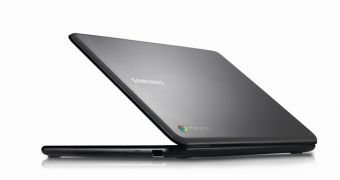The second day of the Google I/O 2011 conference was all about Google Chrome. But, while Google didn't have much to say about the web browser, aside from touting its performance, features and so on, it did have plenty to say about Chrome OS and the devices it's going to run on.
More than six months late, Google is finally making Chrome OS available to consumers. The operating system is pretty much complete now, at least as complete as it's going to get for an initial launch meaning that it's functional in most use cases.
Google has been running a pilot program for the past six months or so, it shipped tens of thousands of Cr-48 netbooks to users, developers and companies to polish the operating system and the hardware itself.
Now all of that is over, Chrome OS netbooks, or Chromebooks as Google would like you to call them, see the video below for a PR-ish explanation, are hitting stores this summer, on June 15 in the US and several European countries.
Two devices will be available at launch, each with or without built-in 3G, one from Samsung and one from Acer. The Samsung device is the more interesting one while the Acer Chromebook is the value proposition.
Both devices will feature a dual-core Atom process clocked at 1.66 GHz, 16 GB SSD storage and so on, the guts of the two machines are pretty similar and what you'd expect from a modern netbook/ultraportable.
The Samsung Series 5 Chromebook, with a 12.1 inch display and 8.5 hours of battery life, will cost $429 in the US or $499 if you want the 3G version.
The Acer Chromebook, with a 11.6 inch display and only 6 hours of battery life, will sell for $349 for the WiFi-only version and the price of the 3G option hasn't been announced yet.
The Chromebooks will be available in the US as well as in the UK, France, Germany, Spain, the Netherlands and Italy starting June 15. Prices for each country haven't been revealed.
As was previously announced, the 3G Chromebooks come with 100 MB of free mobile traffic each month provided by carriers in the respective countries, however, it seems that this offer runs out after two years and is not, as previously expected, for the life time of the device.
Even more interesting, Google is also making these devices available to businesses and educational institutions with a subscription, starting at $20 per month, which covers the device but also warranty, support and even hardware upgrades.
While Google is still sticking to the same story, Chrome OS is for notebooks and this is what the company is focusing on, it also showcased a Chromebox, a device that's more akin to a traditional desktop, albeit far smaller.
Users would need to plug in a keyboard, mouse and a display, but it's designed for places where a big display is preferred over mobility. As for other form factors, meaning tablets, don't expect to see Chrome OS on a tablet any time soon even though Google has clearly been playing around with the idea.

 14 DAY TRIAL //
14 DAY TRIAL //